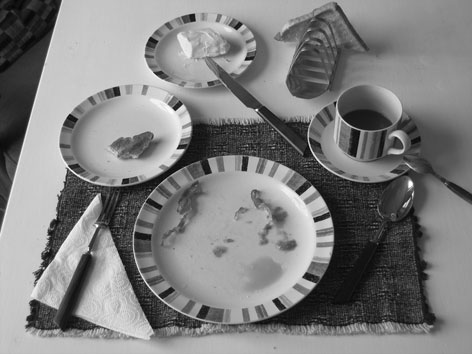Gabriel Kuri and the Design Archives receive critical aclaim at the Brighton Photo Biennial 2006
15 Aug 2013

“One of the wonderful things about making art is that, in the best possible cases, it can make one see things in everyday objects and their grammar that one would not otherwise.” - Gabriel Kuri 2006.
Kuri’s eaten breakfast on Design Council-approved crockery was one of the most public components of the 2006 Brighton Photo Biennial (www.bpb.org.uk/). Placed in five locations throughout the city, the identical installations were the result of Kuri’s research in the University’s Design Archives and his interest in the photographic prints that comprise the Design Council Picture Library. Kuri was fascinated by the formulaic representation of approved consumer goods that make up the collection, but even more so, he wanted to intervene, to recreate an image that might recall, through repetition, its original and those of its kind in the archive, but which completed the Council’s modernist project, as he put it, “with human imperfection”.
Following on from archival research, Kuri took to the streets, trawling second hand shops from Emmaus in Portslade, Snoopers Paradise in the North Laine, to ‘In Retrospect’ in Upper St James’ Street and other Kemp Town emporiums. He was looking for the kinds of tableware depicted in the photographs but, fifty years on, used, discarded and re-circulating; physically mapping the post-war trajectory from austerity, to affluence, to twenty-first century excess. There is a tension between Kuri’s awareness of the demise of the post-war utopian vision and the real humour he expresses in his celebration of human viscerality in repeated eating rituals, preferences and habits. Yet herein lies the historical move from a society that aspired to have enough, to one where many now have too much.
Kuri graduated in 1992 from the Escuela Nacional de Artes Plasticas at the University in Mexico City and prior to this he spent several years in the workshop of artist Gabriel Orozco. He completed his MA at Goldsmiths College in London in 1995. Solo exhibitions in the past few years include Galeria Kurimanzutto, Mexico City (2003); Galeria Franco Noero, Turin; and MUHKA, Antwerp (2004). He was included in the 2003 Venice Bienniale and in State of Play at the Serpentine Gallery (2004). In a recent publication, the curator Dieter Roelstraete suggested that what sets Kuri’s work apart from his peers and predecessors is, ‘ ...his refreshingly lucid approach, both in terms of conceptual commitment and formal resolution, to that over-familiar province of human behaviour and material culture that is the very lifeblood of our present-day ‘glocal’ society: the eternal tides of trade, and the symbol laden economies and ecologies of exchange, both real and symbolic, they simultaneously rest upon’. [Compost Index, (Roma Publications, 2005), p. 5] This indicates well, why the Design Archives residency proved such an attraction to him and how the outcome takes the form it does. Distinctive in its own right, it is, nonetheless, part of a longer term line of enquiry.
For the Design Archives, this project has been an exciting development of our work with artists, which began with Marysia Lewandowska and Neil Cummings’ residency in 2000. For this Biennial project, Kuri orchestrated an exciting and ambitious collaboration that broached the limits of photographic representation and in¬deed, of the archive itself. Kuri involved a wide range of local people and businesses as well as students on the CFAP degree. His manner of working and his infectious conviction in what he sets out to do wins him many allies. The Design Archives is grateful to Biennial curator Gilane Tawadros for such an inspired introduction, and for Faculty Research Support fund¬ing that made it possible. We look forward to 2008.